I started into led with hlg 132,288 boards and they are still going strong today. Later I brought some Chinese 312, 288, 800 boards. Haven’t been reading around the forum lately but recently have seen these beautiful bar grows. I’m considering doing a 3x3 bar light to try it out. Which side are you on. Pros/Cons, cost vs efficiently. Let’s talk about it
Bars vs Boards
- Thread starter budman410
- Start date
lokie
Well-Known Member
I have no LED lights so can not answer your question.I started into led with hlg 132,288 boards and they are still going strong today. Later I brought some Chinese 312, 288, 800 boards. Haven’t been reading around the forum lately but recently have seen these beautiful bar grows. I’m considering doing a 3x3 bar light to try it out. Which side are you on. Pros/Cons, cost vs efficiently. Let’s talk about it
That said, your experience with them would seem to be extensive in comparison.
May I ask how much you have invested in the LED experience you have?
Cost AND the fact that tech changes so fast, is the biggest factor that has kept me from upgrading, it would be hard to justify upgrading regularly.
pulpoinspace
Well-Known Member
the way you get penetration deep into the canopy is by having multiple sources of light spread out over the canopy. for this reason cobs, strips, and boards can all be similarly effective and efficient. the key is getting them spread out and intensifying the light in the corners, where multiple light sources won't reach, and less in the center, where overlap will increase intensity. following that logic, u can see that strips are better than boards, unless u run a lot of boards and spread them out, which gets expensive fast. people will tell you strips are the best. and there are plenty of strip build referenced on here to copy if thats the path you choose. personally i feel like cobs/pucks/qb96 are a great in between, especially in smaller tents like yours. offers a great compromise of intensity, spread and efficiency. however, vertical space can be a limiting factor. strip builds also offer the lowest profile designs. having said all that my rec would be:
4-6 cobs, chilled pucks or qb96 ran at 50-80w each for a total of ~320w
i would build something like one of these, but probably use the qb96 given their price right now.

 timbergrowlights.com
timbergrowlights.com
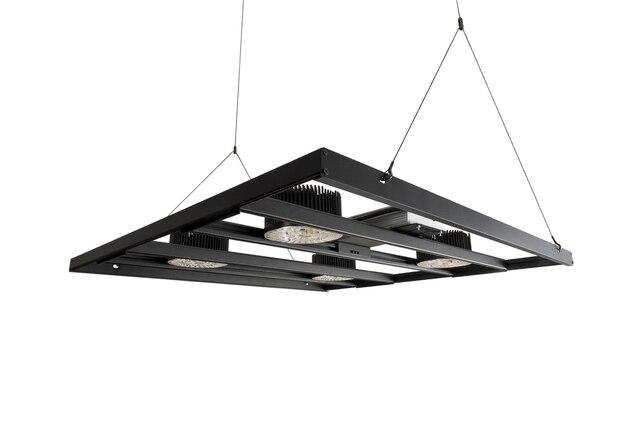
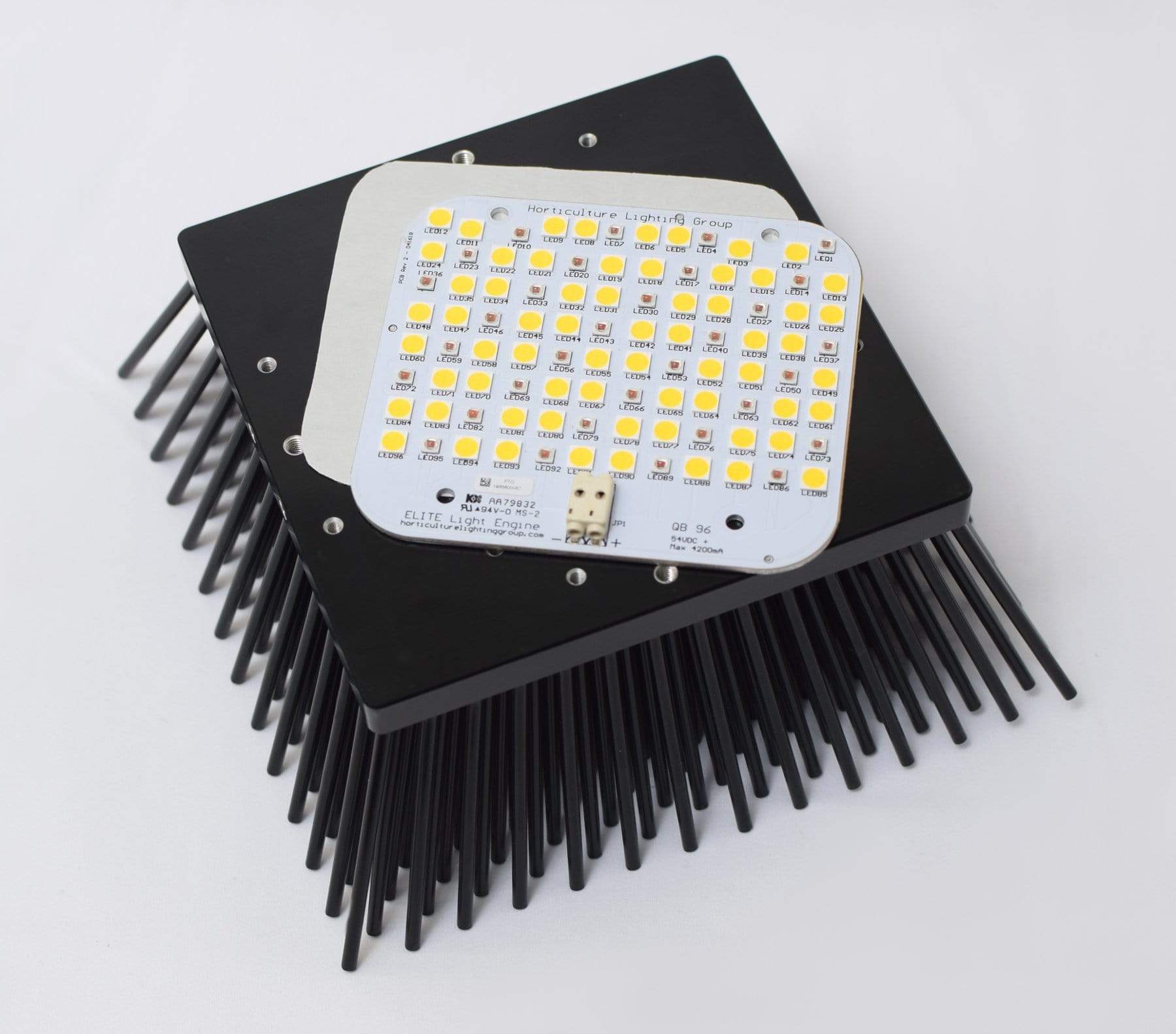
 horticulturelightinggroup.com
horticulturelightinggroup.com
4-6 cobs, chilled pucks or qb96 ran at 50-80w each for a total of ~320w
i would build something like one of these, but probably use the qb96 given their price right now.

Model 4VS
This high powered 4 COB LED light fixture features Bridgelux Vero29 COBs and dual Meanwell drivers for maximum uptime. Remote driver placement helps with managing heat and custom color temperatures are available. Innovative design for use in a 3 x 3 to a 3.5 x 3.5 foot coverage area.


QB96 Elite V2 Engine
QB96 Elite V2 is a white LED Board with boosted red spectrum. Each Board is powered by 64 high power white LED, 16 630nm Red LED and 16 660nm Deep Red LED.
 horticulturelightinggroup.com
horticulturelightinggroup.com
Last edited:
newbplantgrower420
Well-Known Member
LED Bars
Pros
- Even canopy distribution
- Can get canopy closer to the lights just because its so evenly distributed. It shouldnt burn the top of the canopy. Wouldnt even recommend doing this.... mistakes just happen sometimes and your plant gets taller than you expected.
Cons
- More expensive than LED boards.
LED Boards
Pros
- Cheaper than Bars
Cons
- Okay light distribution. Better than HPS and CMH....but not as good as LED bars.
- Cant get canopy as close to light as Bars cause its more focused in the middle. Itll burn the middle of the canopy where most of the light hits.
I got boards in my veg a few months ago. Its light distribution is way better than the 600w hps I was running though. It does pretty well cause I have boards up high and they all overlap light on the edges... so its pretty even across the canopy overall.
I coughed up some extra cheese just to get the bars for my bloom.
Pros
- Even canopy distribution
- Can get canopy closer to the lights just because its so evenly distributed. It shouldnt burn the top of the canopy. Wouldnt even recommend doing this.... mistakes just happen sometimes and your plant gets taller than you expected.
Cons
- More expensive than LED boards.
LED Boards
Pros
- Cheaper than Bars
Cons
- Okay light distribution. Better than HPS and CMH....but not as good as LED bars.
- Cant get canopy as close to light as Bars cause its more focused in the middle. Itll burn the middle of the canopy where most of the light hits.
I got boards in my veg a few months ago. Its light distribution is way better than the 600w hps I was running though. It does pretty well cause I have boards up high and they all overlap light on the edges... so its pretty even across the canopy overall.
I coughed up some extra cheese just to get the bars for my bloom.
GBAUTO
Well-Known Member
I think it really comes down to form factor.
Boards and cobs are just as efficient as strips but strips do allow better uniformity at the expense of penetration.
If you're limited in headroom, strips make more sense but if you can hang them higher boards/cobs will get less drop-off through the canopy.
Boards and cobs are just as efficient as strips but strips do allow better uniformity at the expense of penetration.
If you're limited in headroom, strips make more sense but if you can hang them higher boards/cobs will get less drop-off through the canopy.
I’m a newbie in the led world only been growing with them for a year or so. The 3x3 space is a “test” area for strips/bars. I have rooms that I need to fill with new lights.I have no LED lights so can not answer your question.
That said, your experience with them would seem to be extensive in comparison.
May I ask how much you have invested in the LED experience you have?
Cost AND the fact that tech changes so fast, is the biggest factor that has kept me from upgrading, it would be hard to justify upgrading regularly.
I usually build my light fixtures so for a 10x12 space how much of a cost and build difference between these new bars and boards.
Ps: don’t let the unknown scare you to stick with the if it ain’t broke don’t fix it. A quality led from 2 years ago is likely better then some cmh/hps setups
Prawn Connery
Well-Known Member
It's horses for courses. So I'm going to go against the grain here and suggest that there are certainly applications where boards provide a better use of light, such as a one-plant, one-station open-room type grow (below). In this layout, you want most of the light concentrated over the middle of each plant, with peripheral light overlapping at the edges and penetrating into the canopy of the neighbouring and adjacent plants.

There's also no substitute for wall-to-wall boards – if you can afford it. The set-up below is not ideal – you'd really want to turn the board current down to improve efficiency and run them closer to the plants – but the grower didn't want the hassle of raising his lights every night as the plants stretched, so he hung them high and ran them hard (not that hard, but you get the idea). Honestly, strips have no chance of beating wall-to-wall boards in terms of light coverage, efficiency and penetration. It simply comes down to cost.

I am biased (because I was involved in a company that sells boards), but I'd also argue that for DIYers, boards are easier to work, especially if you are using pre-fabbed heatsinks
Don't get me wrong – I've built and grown very successfully with strip builds – but the yields didn't compare to wall-to-wall boards at the same wattage. This is my set-up.




There's also no substitute for wall-to-wall boards – if you can afford it. The set-up below is not ideal – you'd really want to turn the board current down to improve efficiency and run them closer to the plants – but the grower didn't want the hassle of raising his lights every night as the plants stretched, so he hung them high and ran them hard (not that hard, but you get the idea). Honestly, strips have no chance of beating wall-to-wall boards in terms of light coverage, efficiency and penetration. It simply comes down to cost.

I am biased (because I was involved in a company that sells boards), but I'd also argue that for DIYers, boards are easier to work, especially if you are using pre-fabbed heatsinks
Don't get me wrong – I've built and grown very successfully with strip builds – but the yields didn't compare to wall-to-wall boards at the same wattage. This is my set-up.



wietefras
Well-Known Member
A 2' strip Samsung H-Influx or F-series Gen 3 contains half the leds of a board. Two strips are about half the price of a board. So strips would be cheaper. You don't need an expensive heat sink either. Just mount them to aluminium U-extrusions.LED Bars
Cons
- More expensive than LED boards.
LED Boards
Pros
- Cheaper than Bars
Also something to keep in mind, hanging the lights closer to the canopy can save a lot on light loss on the walls. In a small tent (2x2) you can easily lose 40% and up to half your light on the walls with. Cutting the hanging height in half by going with led strips will save you half of that wall loss.
wietefras
Well-Known Member
Nope, led strips give you better penetration.strips do allow better uniformity at the expense of penetration.
As explained a few posts up
Led strips offer by far the best spread of light points and therefore the best light diffusion and thus light penetration.the way you get penetration deep into the canopy is by having multiple sources of light spread out over the canopy.
GBAUTO
Well-Known Member
My personal experience has to dispute that.Nope, led strips give you better penetration
pulpoinspace
Well-Known Member
They can, but what if you just use like 2 strips and drive them hard, versus covering your whole canopy with boards driven soft? so to just say "strips are better" is not entirely the full picture. when you implement either solution properly, you get good penetration. it can be done cheaper with strips is what i think you're saying.Nope, led strips give you better penetration.
As explained a few posts up
Led strips offer by far the best spread of light points and therefore the best light diffusion and thus light penetration.
i would agree with this. i think there is a point where cramming more softly driven diodes into a space has got to hit diminishing returns. there is something to be said for intensity as well. thats why i like cobs/pucks. a balance between diffusion, penetration, itnensity, efficiency, etc.My personal experience has to dispute that.
Prawn Connery
Well-Known Member
Haha! Old "wiety" has me on ignore and hasn't seen my posts in this thread. The reason I'm on ignore is because we have already had this debate and he came off second-best after he faked a PAR map to try to prove his point.
I have provided PAR maps and explanations about why wall-to-wall boards provide better coverage and efficiency already in this thread: https://rollitup.org/t/hlg-550-v2-vs-1k-hps-single-end.995039/page-3#post-15183151
I invite all to read and make up their own minds
Editted to provide a direct link to the PAR maps: Boards vs Strips < this settles the argument once and for all
I have provided PAR maps and explanations about why wall-to-wall boards provide better coverage and efficiency already in this thread: https://rollitup.org/t/hlg-550-v2-vs-1k-hps-single-end.995039/page-3#post-15183151
I invite all to read and make up their own minds
Editted to provide a direct link to the PAR maps: Boards vs Strips < this settles the argument once and for all
Last edited:
end_of_the_tunnel
Well-Known Member
Nice examples of coverage in the link you posted. Envy your experience with dialux.Haha! Old "wiety" has me on ignore and hasn't seen my posts in this thread. The reason I'm on ignore is because we have already had this debate and he came off second-best after he faked a PAR map to try to prove his point.
I have provided PAR maps and explanations about why wall-to-wall boards provide better coverage and efficiency already in this thread: https://rollitup.org/t/hlg-550-v2-vs-1k-hps-single-end.995039/page-3#post-15183151
I invite all to read and make up their own minds
Editted to provide a direct link to the PAR maps: Boards vs Strips < this settles the argument once and for all
Think there is something to possibly be gained from intensity hotspots from cobs/pucks. Just a gut feeling that an individual plant as a whole can offset high exposure of part of the plant. I'm talking plants sized like we see in the forums and other media.They can, but what if you just use like 2 strips and drive them hard, versus covering your whole canopy with boards driven soft? so to just say "strips are better" is not entirely the full picture. when you implement either solution properly, you get good penetration. it can be done cheaper with strips is what i think you're saying.
i would agree with this. i think there is a point where cramming more softly driven diodes into a space has got to hit diminishing returns. there is something to be said for intensity as well. thats why i like cobs/pucks. a balance between diffusion, penetration, itnensity, efficiency, etc.
There are tradeoffs with whatever school of lighting you follow. Time, electricity and labour are down to individual choices.
I always return to this example by smart grow systems of large diode arrays. Note these racks only have a spacing of 27"/~69cm.
Somewhere they have a SlideShare powerpoint presentation. Their suggested numbers on planting density fill me with foreboding.
256 count for spindly growers or 120 for bulkier cultivars in 4 x 4. You see very few examples of this type of growing anywhere. Reminds me of Dr Bud Greengenes grows. (Not to be confused with the other Greengene)

wietefras
Well-Known Member
You dispute common logicwe have already had this debate and
Lol, you are too funny. I didn't fake anything. I created one of your poor looking par maps because you insisted I use that shitty format. Those charts are completely useless and look like you drew them in paint anyway. But still I drew one to show what it would look like since you keep having trouble understanding such simple concepts.he came off second-best after he faked a PAR map to try to prove his point.
Of course you could look at PPFD par maps of bar lights in real life situations killing COB and Board based fixtures over and over
Its really simple. Imagine how the light spreads. Take a flash light. Lift it up until it covers a certain area. Now take 4 flashlights and uniformly spread them over the same area. To cover the same area do you need to lift the flashlights to the same height? No of course not each flashlight only needs to cover one quarter of the surface and therefore needs to be lifted only half as high.
This is common knowledge. Why would you need a paint drawn "par map" for something that simple?
Last edited:
wietefras
Well-Known Member
OK that one is a bit harder to understand perhaps, but that does not help penetration or anything for that matter.one piece to hang/higher power/more concentrated diode array...typically higher light intensity overall.
Light doesn't "penetrate" deeper because it all originates from one point. Light penetrates deeper when it can more easily slip through the canopy. That what you get with spreading the light over the space.
Also, the light from multiple points is just as strong as it is when spread out. All of it overlaps. If you have 4 25W bulbs vs one 100W bulb you get the exact same intensity at the canopy.
Below the canopy the light intensity is determined by how much slips between the leafs.
Even if there is no canopy, you will find that higher light intensity will remain from 4 light sources closer to the surfas as opposed to one big one hanging twice as high.
Also think, if any of this "more powerful light sources give better penetration" was trur, why did we ever switch to COBs and le dstips anyway? Why not cluster all of them in the center of the grow and hang then high up on the ceiling? Because that's not it works is why.
Last edited:
wietefras
Well-Known Member
Yes you can take away that you get exactly the same with boards. A board is simply a slightly bigger COB/puck. yet with COBs you'd generally hang a lot more of them and therefore you get more and smaller hotspots in return. ie they are actually better at ditributing the light.Think there is something to possibly be gained from intensity hotspots from cobs/pucks.
for instance see how far the light must spread to cover the area with boards, COBs and strips.
The light from one board needs to spread at least 12" to cover a 2x2 area.
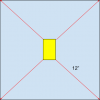
Instead 4 COBs only need to spread to 8":
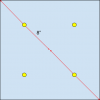
And two strips only for 6":
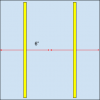
In fact Boards need to be put at at least 18" over a 2x2 area because the light might need to spread only 12"from the edge, but then you get a massive hotspot in the center still since the bulk of the light is still far away from the edge of the board.
Last edited:
wietefras
Well-Known Member
Because boards are twice as expensive. To do what you suggest you'd be spending 4 times as much as you would with a strip light.They can, but what if you just use like 2 strips and drive them hard, versus covering your whole canopy with boards driven soft?
Prawn Connery
Well-Known Member
Seriously, just because you don't understand how Dialux works, nor know what an IES file is, doesn't mean the rest of us don't.You dispute common logic
Lol, you are too funny. I didn't fake anything. I created one of your poor looking par maps because you insisted I use that shitty format. Those charts are completely useless and look like you drew them in paint anyway. But still I drew one to show what it would look like since you keep having trouble understanding such simple concepts.
Of course you could look at PPFD par maps of bar lights in real life situations killing COB and Board based fixtures over and over
Its really simple. Imagine how the light spreads. Take a flash light. Lift it up until it covers a certain area. Now take 4 flashlights and uniformly spread them over the same area. To cover the same area do you need to lift the flashlights to the same height? No of course not each flashlight only needs to cover one quarter of the surface and therefore needs to be lifted only half as high.
This is common knowledge. Why would you need a paint drawn "par map" for something that simple?
Dialux is sound, the IES files are real, and you simply do not understand the technology used to create those PAR maps. That is your issue, no-one else's.
Indeed, it is precisely because you don't know how to use the technology that you had to computer draw your own "PAR map" and try to pass it off as a Dialux simulation. The problem is, I know how to use the program, so I knew at once it was a fake. You were caught out and now you are in denial, trying to suggest Dialux and IES files do not exist and are therefore a "shitty format" or "completely useless".
Those PAR maps have been replicated in the real world with physical PAR mapping using a hand-held Apogee PAR meter, and are accurate to within 5%.
But even if you don't believe me, I will appeal to your sense of "logic" – how could a few strips of LEDs bunched closely together (I am talking about the physical spacing of the LEDS on the strips themselves) provide a more even coverage than double or triple the number of LEDs spaced evenly and further apart? There is no way strips of light can beat wall-to-wall LEDs spaced evenly across the entire roof of a grow tent or room. To argue otherwise is folly.
In this instance, logic favours my empirical evidence – not your opinion.
